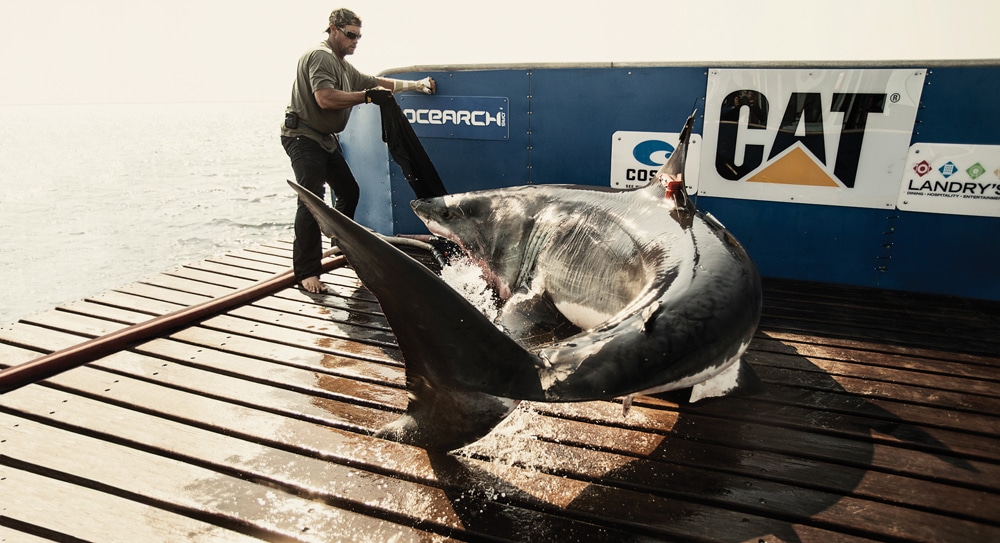
Tracking Great White Sharks With Ocearch
On Aug. 20 a plane flying low over Monomoy Island, off the Massachusetts coast, spotted a dark shape in the water, not far from where a group of seals were moving in and out of the surf.
The pilot radioed the crew of nearby anglers and said, “I’ve got one very tight to the beach.” With that news the crew mobilized its fishing platform, a Contender 28 Tournament with twin 300 hp Yamahas, within range.
Using an elaborate bait-and-switch technique, the crew on the Contender teased the fish until it moved in just behind the transom. At that moment one of the crew members pulled a decoy, meant to resemble a swimming seal, out of the water while another threw in a tuna head impaled with a giant Mustad Perfect Circle 27/0 hook and a stainless-steel chain leader. The fish ate the tuna head and started peeling out coiled rope. Suddenly, that dark shape exploded out of the water, looking about the size of a Subaru Forester. It was a 14-foot-long great white shark. All of 2,300 pounds. Now all they had to do was steer the fish back to a research vessel so one of the team, Capt. Brett McBride, could jump into the water with it.
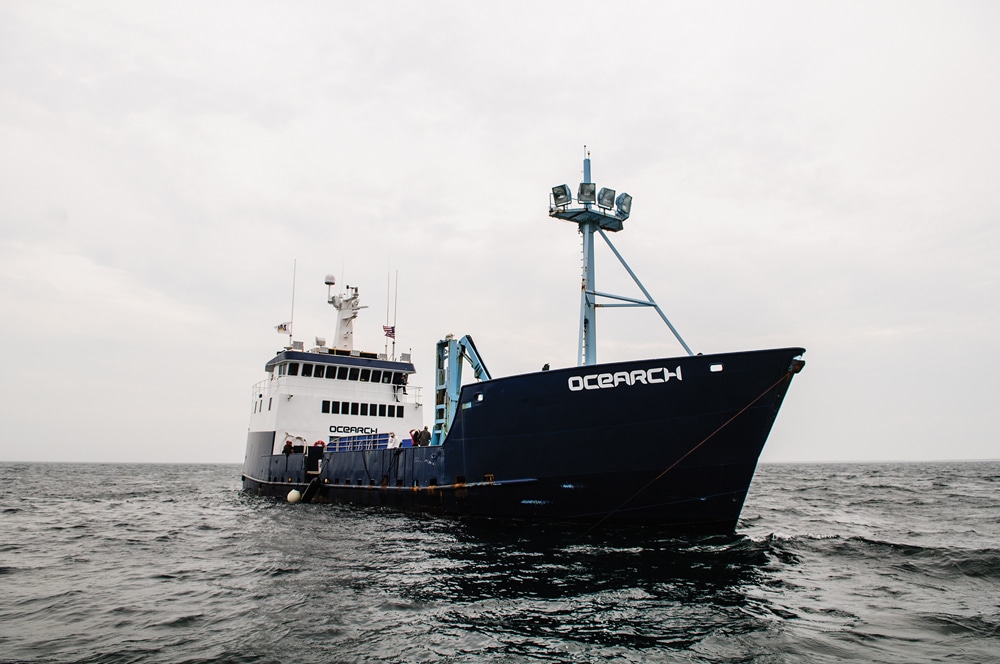
Tracking Great White Sharks With Ocearch
For the crew aboard the Contender and the Ocearch shark tracker team, this was a very good day. This is what Ocearch, a nonprofit organization dedicated to studying the world’s largest marine animals, does. It has conducted expeditions all around the world, including Australia, South Africa and here, in Cape Cod. It’s a thrill ride, but that’s not the reason crew members do it.
“People’s perceptions of sharks are driven by emotion, and there’s a lack of data,” explained Chris Fischer, the group’s founder and expedition leader. “We give scientists access to these animals so they can gather the data.”
Two days after the Ocearch crew hooked this shark within spitting distance of Cape Cod, they invited us on board to describe the work that goes into catching such a spectacular animal, and hopefully to provide us a front-row seat to catching another one.
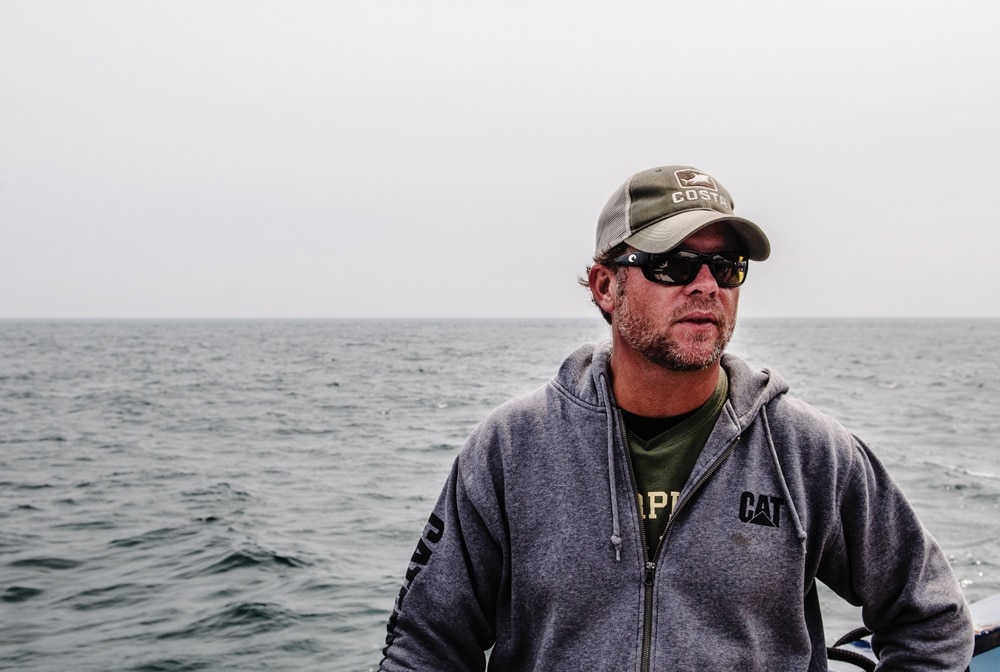
Tracking Great White Sharks With Ocearch
Location, Location
We stood on the docks at a marina in Chatham, Massachusetts, waiting for an aluminum RIB made by Safe Boats to pick us up and escort us out to the Ocearch mothership, a 126-foot vessel that was once used for king crab fishing in the Bering Sea. We anticipated a long ride to a remote blue-water location, but when we boarded the RIB we were informed it would take less than 10 minutes. The M/V Ocearch sat anchored, and chumming, less than a mile off the beach.
As we left the inlet and hugged the shoreline of Monomoy en route to the mothership, the reason became readily apparent. From a distance the large brown masses on the beach looked like large piles of riprap, or rocks, but then we noticed the rocks moving. The beach was covered with seals. The National Marine Fisheries Service estimates the local seal population to be somewhere around 16,000. Great white sharks, like the one hooked by Ocearch only two days prior, like to eat them.
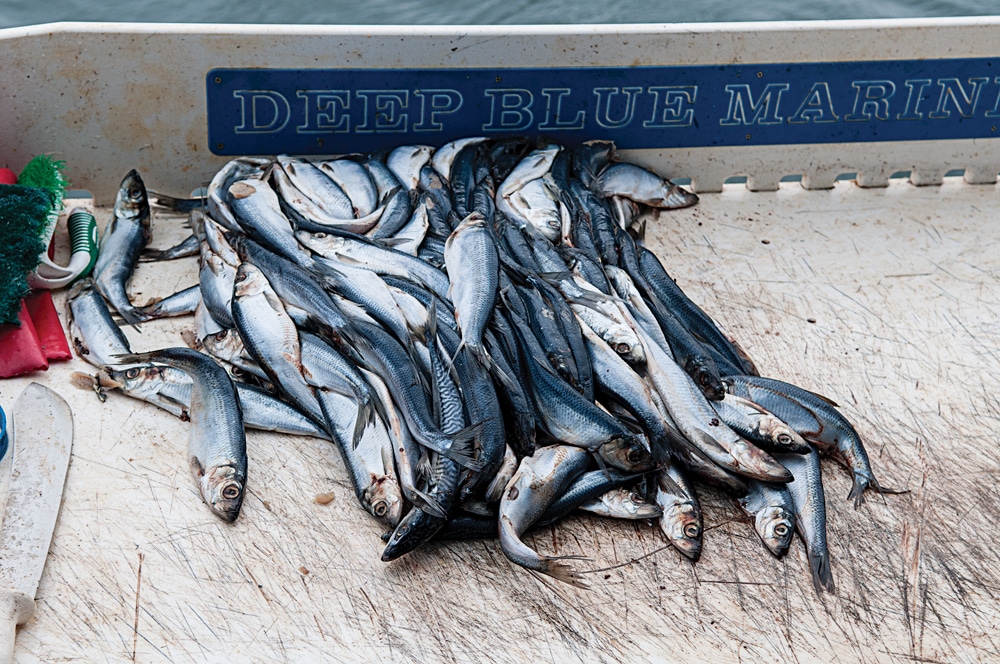
Tracking Great White Sharks With Ocearch
We idled close to the shore as seals popped their heads out of the water within feet of our boat. Staring at us with confused curiosity, they reminded us of dogs. We counted at least three with long, jagged scars on their backs. Bite marks.
“Yesterday a family anchored nearby and started swimming to the beach,” recalled Dave Gallo, the Safe Boats captain. “They even had their dog with them. We had to tell them that wasn’t the smartest idea in the world.”
The good news for that family, and for the tourists who flock to Cape Cod’s beaches every summer, is that the great whites aren’t that interested in people.
“They avoid boat and human interaction more than any fish I’ve ever seen,” said Chris Fischer, holding court once we were all safely aboard the old crabber.
Their elusiveness is good news for most people, but it makes Fischer’s task more daunting than it seems. Fortunately, his crew is up to the challenge.
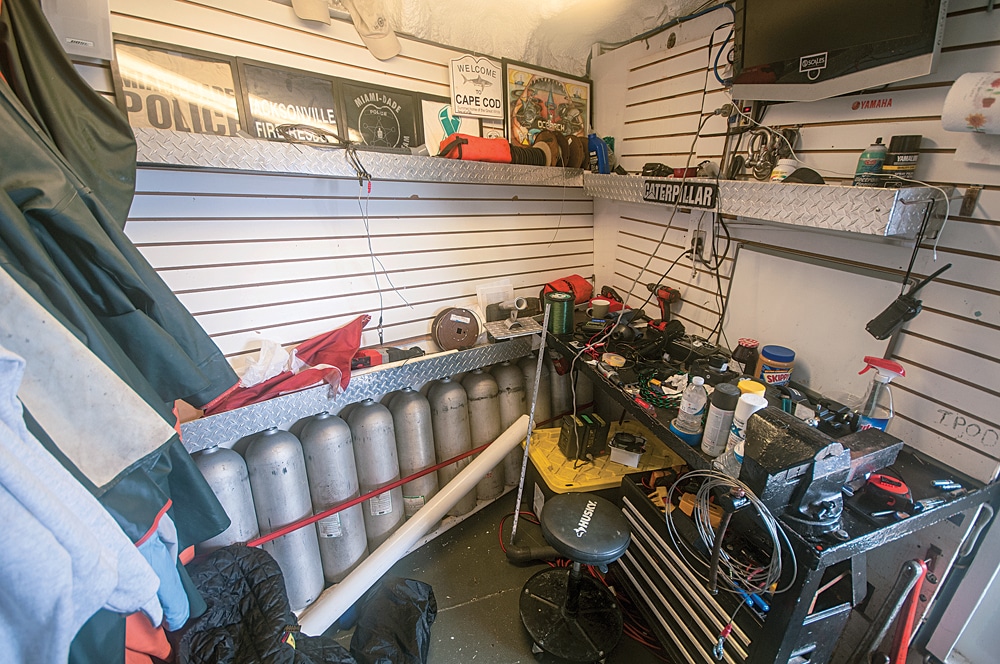
Tracking Great White Sharks With Ocearch
Big-Game Angling
When the angling team aboard the Contender hooked that 14-footer, the team relied on countless hours of experience with billfish and other large pelagics. Prior to founding Ocearch, Fischer and his wife, Melissa, traveled the world chasing the largest fish that swim, and they hosted a television show about it called Offshore Adventures.
“Getting good at catching and releasing big fish is what led to this,” he said. “We’re catching 2,000- to 4,000-pound fish in under an hour.”
The tricky part is getting a great white shark to eat at all. Since 2007, Fischer’s crew has undertaken 17 missions to tag and release great whites around the globe. He believes the Atlantic population is the wildest, most untouched in the world. In their 2012 expedition to Cape Cod, the Ocearch shark tracker crew hooked just two sharks. In those cases, Fischer teased the fish right alongside the Contender with chum on the end of a gaff. As the shark glommed onto the chum, McBride reached over the gunwale and embedded the circle hook — with his bare hands.
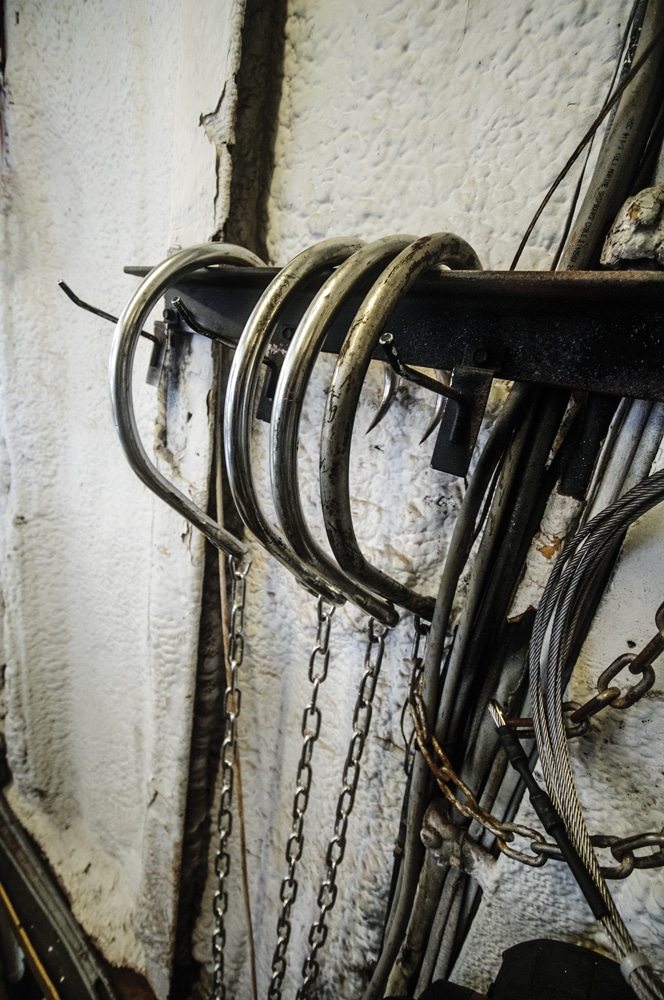
Tracking Great White Sharks With Ocearch
Fortunately, the 14-footer off Monomoy ate the tuna head and set the hook herself. Then, moments after she breached, the team aboard the Contender sprang into action. Co-captain Jody Whitworth wrangled the fish by hand line, along with first mate Todd Goggins. While they held it close to the boat, McBride affixed orange floats to keep it close to the surface. Then the crew used the Contender to steer the fish toward the research vessel.
“We coax the fish into taking the lead,” Fischer explained. “So it’s almost walking us, like a dog.” As they worked the fish close, the crew aboard the M/V Ocearch lowered a hydraulic platform capable of lifting 75,000 pounds into the water. From there, the crew swam the fish onto the platform. Then the real fun began.
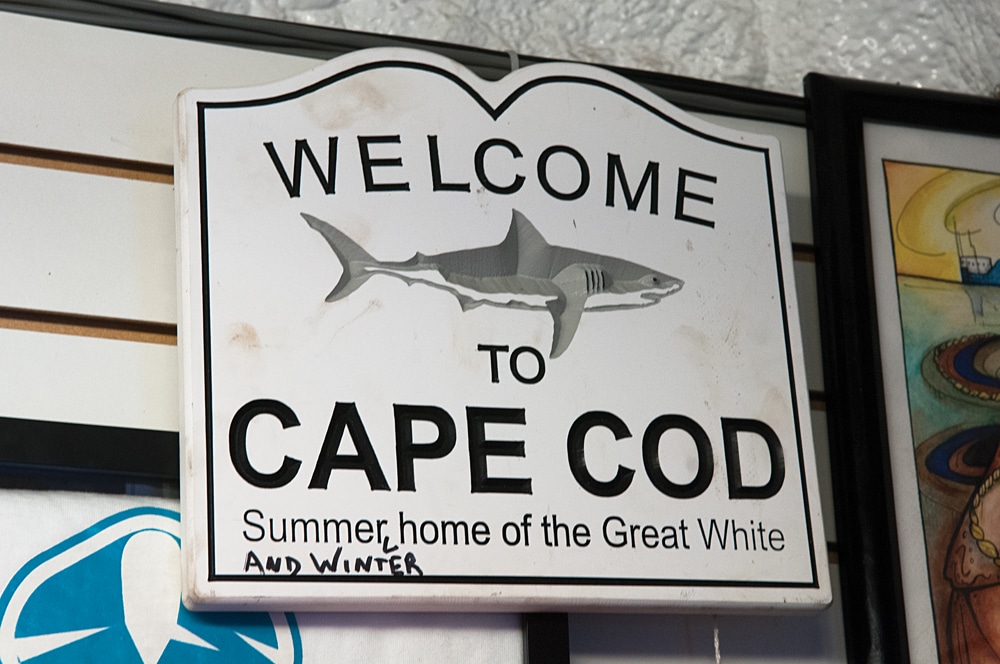
Tracking Great White Sharks With Ocearch
The End Game
As they brought in the 14-footer, the Ocearch shark tracker crew lowered the platform off the vessel’s starboard side. McBride jumped onto the platform to guide it on board and cover its eyes with a black towel. From that moment, the team of scientists on board had 15 minutes to perform 12 scientific procedures.
“It’s like being at a stoplight for 2 1/2 hours and then suddenly have it go green,” said Dr. Greg Skomal, the senior fisheries biologist for Massachusetts Marine Fisheries, in a video interview about the process.
Skomal and other marine biologists from around the country are thrilled that Ocearch provides them these close-up opportunities to study the great white that otherwise would not be possible.
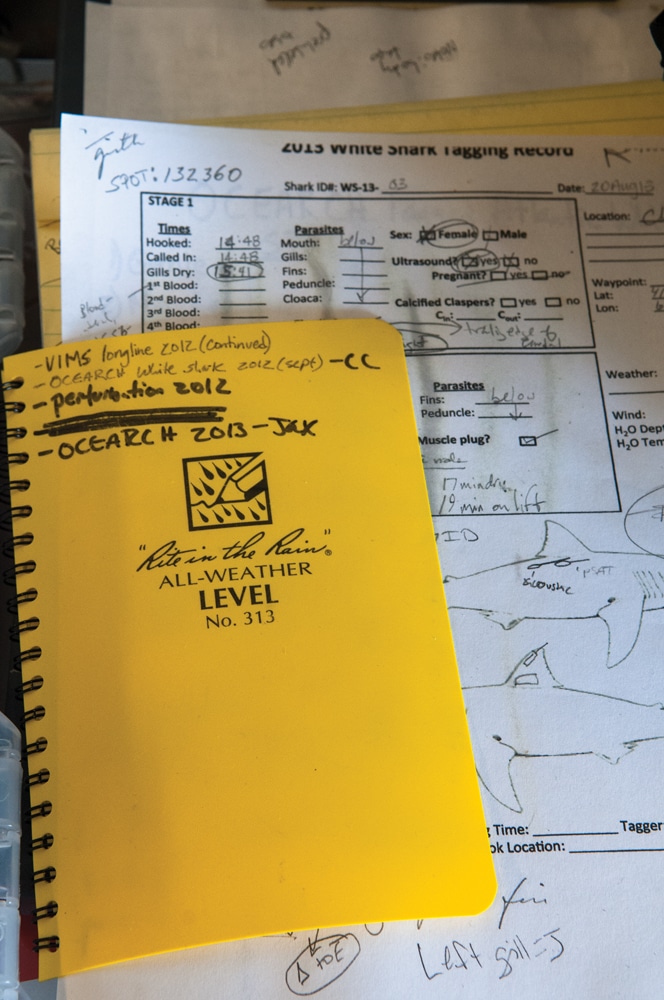
Tracking Great White Sharks With Ocearch
As soon as McBride had the shark subdued, the crew raised the platform and the scientists worked with the efficiency of a NASCAR pit crew. One put fire hoses on either side of the shark’s mouth to run salt water through its gills. Another moved in to draw blood samples, another to run an ultrasound to determine if the shark was pregnant, and others to affix satellite-tracking tags and an accelerometer.
All this was to learn as much as possible about a creature everyone fears, yet no one knows much about. What they’ve learned through tagging is that the sharks tend to move through Cape Cod waters in pods of three or four. Some stay for the season; others migrate up and down the coast and as far out as the Sargasso Sea. Are they breeding off Cape Cod? How many are there?
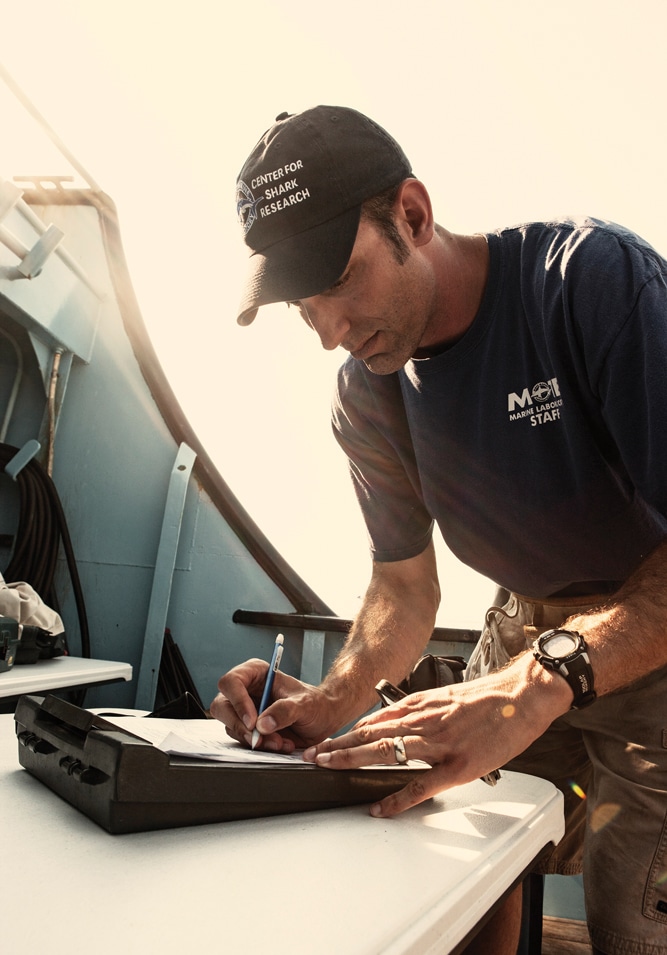
Tracking Great White Sharks With Ocearch
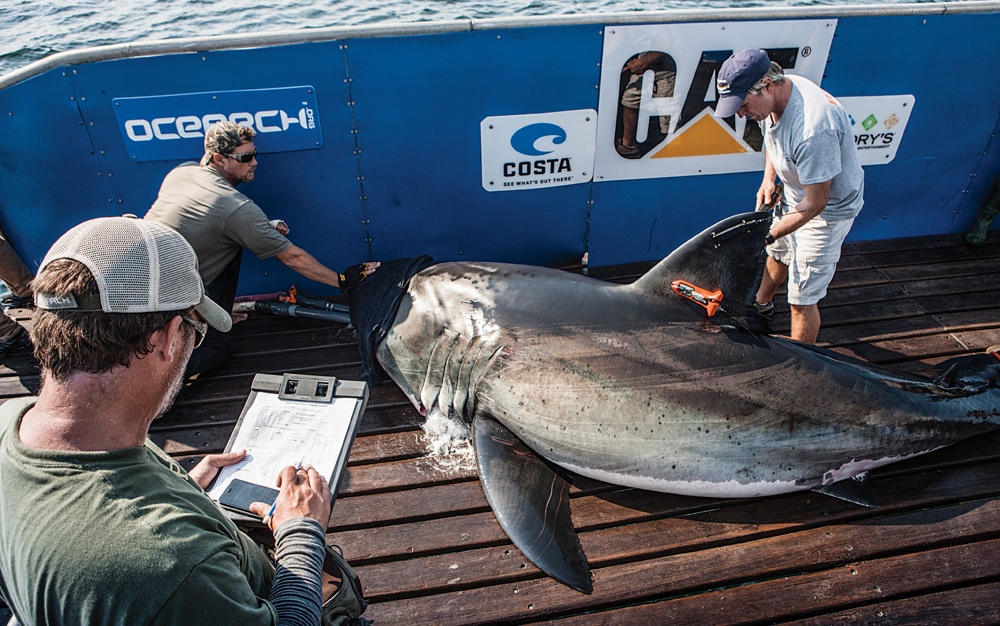
Tracking Great White Sharks With Ocearch
They live about 60 years but do not start reproducing until around age 20.
They can grow up to 20 feet long and weigh up to 5,000 pounds.
They have 300 teeth, but only 24 are showing.
They can smell minute amounts of blood, as little as one part per 10 billion parts of water.
A great white can bite with more than 4,000 pounds of force. Ocearch/R. Snow
After the 15 minutes were up, the scientists had collected more data to provide those answers. And after the shark swam away, they could call this one by name: Katharine (after Katharine Lee Bates, the Cape Cod native who wrote the song “America the Beautiful.”)
When we boarded M/V Ocearch two days later, Katharine could be seen on the satellite tracker, surfacing several times only five miles south of Monomoy. Every future move she makes will bring more answers, and that’s what it’s all about. “We have to solve the fundamental parts of their lives,” Fischer said, “so we can protect them.”
No sharks came into view on the day we spent aboard, but reliving the experience of Katharine proved exciting enough. And for that one day, at least, the seals swimming in the surf at Monomoy Island were safe.
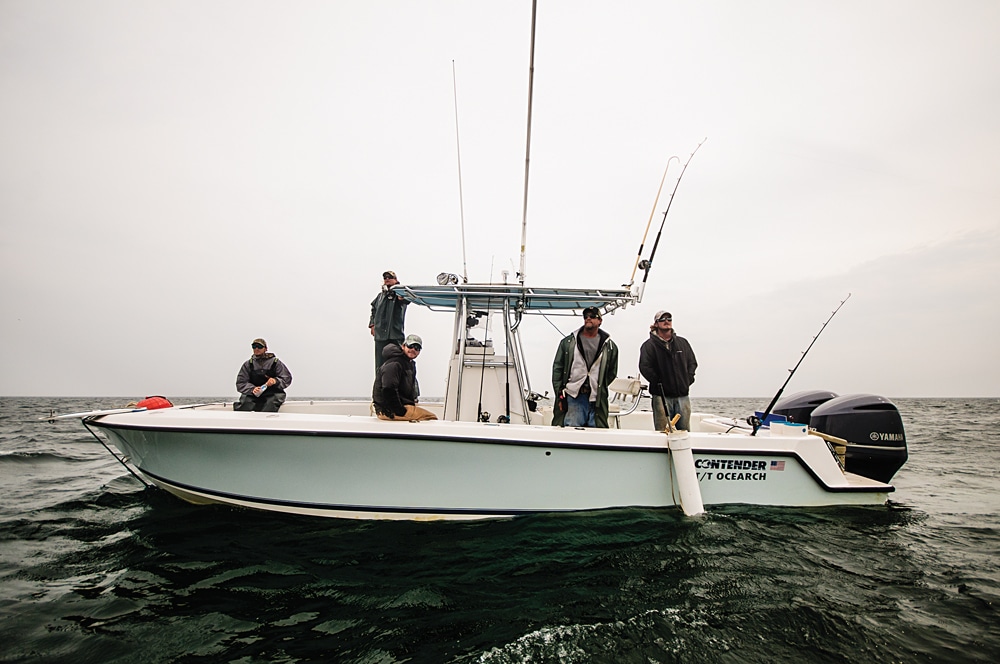
Tracking Great White Sharks With Ocearch
The Contender 28T is made to withstand the rugged conditions of offshore tournament fishing. Good thing. “That’s the boat we actually fight the fish with,” Chris Fischer said. “It’s absolutely bulletproof.” This shark wrangler is mated with twin Yamaha F300s that keep power in reserve for handling two-ton sharks. The boat has to be stable to endure countless hours of chumming at anchor, and nimble enough to zig and zag with the fish as the crew guides it, with hand lines, toward the vessel’s hydraulic platform. How tough is it? Fischer once got caught in a Pacific storm and had to drag it behind the research vessel for days in 10- to 12-foot seas. “When we hauled it back in,” he said, “it started right up as if the whole thing had never happened.” LOA: 28’0″
Beam: 8’10”
Weight: 4,700 lb.
Deadrise: 24 degrees
Fuel Capacity: 185 gal.
Max Horsepower: 600 Matt Boutet









